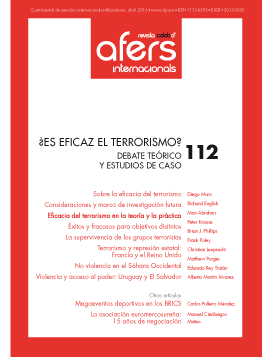Cuando el terrorismo es eficaz: éxitos y fracasos para objetivos distintos
Palabras clave:
terrorismo, violencia, efectividad, Estado Islámico, antiterrorismoResumen
Revista CIDOB d’Afers Internacionals, nº 112
Cuatrimestral (enero-abril 2016)
ISSN:1133-6595 | E-ISSN:2013-035X
DOI: https://doi.org/10.24241/rcai.2016.112.1.69
¿Cuándo es eficaz el terrorismo? El debate sobre la eficacia del terrorismo se ha centrado casi exclusivamente en los cambios que este fenómeno produce en la política estatal; no obstante, ello rara vez es el principal objetivo o el impacto más significativo de esta táctica. Este artículo presenta un marco analítico multinivel para examinar la eficacia del terrorismo, el cual incluye los tres tipos de efectividad que forman parte explícita de su definición: el uso de la violencia y la generación de miedo (táctica) por parte de una organización que trata de sobrevivir y fortalecerse (organizativa) para conseguir fines políticos (estratégica). El análisis muestra las condiciones clave en las que el terrorismo puede eliminar o difundir ideas, polarizar sociedades, fortalecer o destruir organizaciones e infundir miedo,así como aquellas situaciones en las que los logros alcanzados en un área complementan o contradicen los éxitos en otra.
Citas
Abrahms, Max. «Why Terrorism Does Not Work». International Security, vol. 31, n.º 2 (2006), p. 42-78.
Acosta, Benjamin, «Live to Win Another Day: Why Many Militant Organizations Survive Yet Few Succeed». Studies in Conflict & Terrorism, vol. 37, n.º 2 (2014), p. 135-161.
Amnesty International. Ethnic Cleansing on Historic Scale: Islamic State’s Systematic Targeting of Minorities in Northern Iraq, 2014.
Asal, Victor; Gustafson, Daniel J. y Krause, Peter. «How to Get the State to Talk to You: Why Violent Territorial Conquest is an Organization’s Best Hope». Documento de trabajo bajo revision, 2015.
Asal, Victor y Rethemeyer, R. Karl. «Dilettantes, Ideologues, and the Weak: Terrorists Who Don’t Kill». Conflict Management and Peace Science, vol. 25, n.º 3 (2008), p. 244-263.
Begikhani, Nazand. «Sexual Violence as a War Strategy in Iraq». Your Middle East (10 de agosto de 2014).
Berrebi, Claude y Klor, Esteban. «Are Voters Sensitive to Terrorism? Direct Evidence from the Israeli Electorate». American Political Science Review, vol. 102, n.º 3 (2008), p. 279-301.
Blomberg, S. Brock; Gaibulloev, Khusrav y Sandler, Todd. «Terrorist Group Survival: Ideology, Tactics, and Base of Operations». Public Choice, vol. 149, n.º 3-4 (2011), p. 441-463.
Bloom, Mia M. «Palestinian Suicide Bombing: Public Support, Market Share, and Outbidding». Political Science Quarterly, vol. 119, n.º 1 (2004), p. 61-88.
Burrough, Bryan. Days of Rage: America’s Radical Underground, the FBI, and the Forgotten Age of Revolutionary Violence. Nueva York: Penguin Press, 2015.
Chenoweth, Erica y Stephan, Maria. Why Civil Resistance Works: The Strategic Logic of Nonviolent Conflict. Nueva York: Columbia University Press, 2011.
Chrisafis, Angelique. «Charlie Hebdo Staff Ponder Bittersweet New Success after Jihadi Terror Attack». The Guardian (24 de febrero de 2015).
Connable, Ben y Libicki, Martin. How Insurgencies End. Santa Monica, CA: RAND, 2010.
Crenshaw, Martha. «An Organizational Approach to the Analysis of Political Terrorism». Orbis, vol. 29, n.º 3 (1985), p. 465-489.
Crenshaw, Martha. «Theories of Terrorism: Instrumental and Organizational Approaches». Journal of Strategic Studies, vol. 10, n.º 4 (1987), p. 13-31.
Crenshaw, Martha. «How Terrorism Declines». Terrorism and Political Violence, vol. 3, n.º 1 (1991), p. 69-87.
Crenshaw, Martha. «The Effectiveness of Terrorism in the Algerian War», en: Crenshaw, Martha (ed.). Terrorism in Context. University Park, PA: Pennsylvania State University Press, 1995, p. 475-513.
Cronin, Audrey Kurth. How Terrorism Ends: Understanding the Decline and Demise of Terrorist Campaigns. Princeton: Princeton University Press, 2009.
Dershowitz, Alan. Why Terrorism Works: Understanding the Threat, Responding to the Challenge. New Haven: Yale University Press, 2002.
Dwyer, Devin y Bruce, Mary. «Obama Says Sony Made “Mistake” in Canceling “The Interview”». ABC News (20 de diciembre de 2014).
Enders, Walter; Sandler, Todd y Parise, Gerald F. «An Econometric Analysis of the Impact of Terrorism on Tourism». Kyklos, vol. 45, n.º 4 (1992), p. 531-554.
English, Richard. Armed Struggle: The History of the IRA. Londres: Pan, 2012 (reimpresión).
Fisher, Marc. «Lone Wolf Extremists like Dylan Roof are Easy to Develop but Hard to Track». The Washington Post (25 de junio de 2015).
Fleming, Mike. «Gore Verbinski On Cancellation Of North Korea-Based Steve Carell Film». Deadline (17 de diciembre de 2014).
Fortna, Virginia Page. «Do Terrorists Win? Rebels’ Use of Terrorism and Civil War Outcomes». International Organization, vol. 69, n.º 3 (verano de 2015), p. 519-556.
Heger, Lindsay; Jung, Danielle y Wong, Wendy H. «Organizing for Resistance: How Group Structure Impacts the Character of Violence». Terrorism and Political Violence, vol. 24, n.º 5 (2012), p. 743-768.
Hiel, Betsy. «Alert Cabbies, Quick-Acting Police Thwart Suicide Attack in Egypt Tourist Center». TribLIVE.com (13 de junio de 2015).
Hoffman, Bruce. Inside Terrorism. Nueva York: Columbia University Press, 2006.
Horne, Alistair. A Savage War of Peace: Algeria 1954-1962. Nueva York: NYRB Classics, 2006.
Izady, Michael (entrevista). « Columbia University Charts Sectarian Cleansing of Baghdad». Musings on Iraq web site (19 noviembre 2009) (en línea) http://musingsoniraq.blogspot.com.es/2009/11/blog-post.html
Jenkins, Brian. «The New Age of Terrorism», en: Kamien, David (ed.). The McGraw-Hill Homeland Security Handbook. Nueva York: McGraw-Hill, 2006, p. 117-129.
Jensen, Teis. «Danish Newspaper Says Won’t Print Prophet Cartoons». Reuters (9 de enero de 2015).
Jones, Seth. A Persistent Threat: The Evolution of al Qa’ida and Other Salafi Jihadists. Santa Monica, CA: RAND, 2014.
Jones, Seth G. y Libicki, Martin C. How Terrorist Groups End. Santa Monica, CA: RAND, 2008.
Kalyvas, Stathis. «The Paradox of Terrorism in Civil War». The Journal of Ethics, vol. 8, n.º 1 (marzo de 2004), p. 97-138.
Kenney, Michael. «Beyond the Internet: Mētis, Techne, and the Limitations of Online Artifacts for Islamist Terrorists». Terrorism and Political Violence, vol. 22, n.º 2 (2010), p. 177-197.
Krause, Peter. «The Last Good Chance: A Reassessment of US Operations at Tora Bora». Security Studies, vol. 17, n.º 4 (2008), p. 644-684.
Krause, Peter. «The Structure of Success: How the Internal Distribution of Power Drives Armed Group Behavior and National Movement Effectiveness». International Security, vol. 38, n.º 3 (invierno de 2013a/14), p. 72-117.
Krause, Peter. «The Political Effectiveness of Non-State Violence: A Two-Level Framework to Transform a Deceptive Debate». Security Studies, vol. 22, n.º 2 (junio de 2013b), p. 259-294.
Krause, Peter y Evera, Stephen Van. «Public Diplomacy: Ideas for the War of Ideas». Middle East Policy, vol. 16, n.º 3 (2009), p. 106-134.
Kydd, Andrew y Walter, Barbara. «The Strategies of Terrorism». International Security, vol. 31, n.º 1 (2006), p. 49-80.
Lake, David. «Rational Extremism: Understanding Terrorism in the Twenty-first Century». Dialog-IO, vol. 1 (2002), p. 15-29.
Lischer, Sarah Kenyon. «Security and Displacement in Iraq: Responding to the Forced Migration Crisis». International Security, vol. 33, n.º 2 (otoño de 2008), p. 95-119.
Lyall, Jason. «Silver Bullet: Why Decapitation Strikes (Don’t) Work». The Washington Post (19 de junio de 2015).
Lyall, Jason y Wilson, Isaiah. «Rage Against the Machines: Explaining Outcomes in Counterinsurgency Wars». International Organization, vol. 63, n.º 1 (2009), p. 67-106.
Mahoney, Charles. «Accountability or Anonymity? Audiences, Equifinality, and Claims of Responsibility for Terrorist Attacks», paper en el APSA 2014 Annual Metting, American Political Science Association, septiembre de 2014.
Malik, Shiv; Younes, Ali; Ackerman, Spencer y Khalili, Mustafa. «How ISIS Crippled al-Qaida». The Guardian (10 de junio de 2015).
Markey, Patrick. «Bullet Holes and Empty Beaches: The Bleak Outlook for Tunisia’s Tourism». Independent (1 de julio de 2015).
Mesquita, Ethan Bueno de y Dickson, Eric S. «The Propaganda of the Deed: Terrorism, Counterterrorism, and Mobilization». American Journal of Political Science, vol. 51, n.º 2 (abril de 2007), p. 364-381.
Mesquita, Bruce Bueno de; Smith, Alastair; Siverson, Randolph y Morrow, James. The Logic of Political Survival. Cambridge, MA: The MIT Press, 2003.
Nielsen, Richard. «Can Ideas be “Killed?” Evidence from Counterterror Targeting of Jihadi Ideologues». 2016 (en línea) http://www.mit.edu/~rnielsen/decap.pdf
Pape, Robert. «The Strategic Logic of Suicide Terrorism». American Political Science Review, vol. 97, n.º 3 (2003), p. 343-361.
Penland, Neal; KOMO and KATU. «Arson Attacks on Research Center, Tree Farm». ABC News (22 de mayo de 2001).
Phillips, Brian J. «Terrorist Group Cooperation and Longevity». International Studies Quarterly, vol. 58, n.º 2 (junio de 2014), p. 336-347.
Phillips, Brian J. «Enemies with Benefits? Violent Rivalry and Terrorist Group Longevity». Journal of Peace Research, vol. 52, n.º 1 (2015), p. 62-75.
Piazza, James A. «Repression and Terrorism: A Cross-National Empirical Analysis of Types of Repression and Domestic Terrorism». Terrorism and Political Violence (2015), p. 1-17.
Pizam, Abraham y Fleischer, Aliza. «Severity versus Frequency of Acts of Terrorism: Which Has a Larger Impact on Tourism Demand?». Journal of Travel Research, vol. 40, n.º 3 (2002), p. 337-339.
Pomerantz, Dorothy. «In Hollywood, Sony Hack’s Chilling Effect On Movie Pipeline Is Already Being Felt». Forbes (18 de diciembre de 2014).
Rey Tristán, Eduardo y Martín Álvarez, Alberto. «Violencia y acceso al poder en América Latina: Uruguay y El Salvador». Revista CIDOB d’Afers Internacionals, n.º 112 (2016).
Rey Tristán, Eduardo y Martín Álvarez, Alberto. «Dossier “Violencia política y movilización revolucionaria en América Latina desde 1959”. Introducción». Naveg@mérica, n.º 9 (2012).
Sandler, Todd y Scott, John L. «Terrorist Success in Hostage-Taking Incidents: An Empirical Study». The Journal of Conflict Resolution, vol. 31, n.º 1 (1987), p. 35-53.
Sargent, Jordan. «How the Interview Performed Against Sony’s Leaked Internal Projections». Defamer (29 de diciembre de 2014).
Schelling, Thomas. «What Purposes Can “International Terrorism” Serve?», en: Gillespie, Raymond y Morris, Christopher (eds.). Violence, Terrorism, and Justice. Cambridge: Cambridge University Press, 1991, p. 18-32.
Segun, Mausi y Muscati, Samer. «Those Terrible Weeks in Their Camp». Human Rights Watch, Report, 27 de octubre de 2014.
Sonmez, Sevil; Apostolopoulos, Yiorgos y Tarlow, Peter. «Tourism in Crisis: Managing the Effects of Terrorism». Journal of Travel Research, vol. 38, n.º 1 (1999), p. 13-18.
Sprinzak, Ehud. «Rational Fanatics». Foreign Policy, n.º 120 (septiembre-octubre 2000) p. 66-73.
Staniland, Paul. Networks of Rebellion: Explaining Insurgent Cohesion and Collapse. Ithaca, NY: Cornell University Press, 2014.
Thomas, Jakana. «Rewarding Bad Behavior: How Governments Respond to Terrorism in Civil War». American Journal of Political Science, vol. 58, n.º 4 (2014), p. 804-818.
United Nations Security Council. Conflict-Related Sexual Violence. Reporte de la Secretaría General, S/2015/203, 2015.
Wickham-Crowley, Timothy. Guerrillas and Revolution in Latin America: A Comparative Study of Insurgents and Regimes Since 1956. Princeton, NJ: Princeton University Press, 1992.
Young, Joseph K. y Dugan, Laura. «Survival of the Fittest: Why Terrorist Groups Endure». Perspectives on Terrorism, vol. 8, n.º 2 (2014).
Zetter, Kim. «Critics Say New Evidence Linking North Korea to the Sony Hack Is Still Flimsy». Wired (8 de enero de 2015).












